Why Attic Insulation Matters?: A Homeowner’s Guide
- by janesmith

When it comes to keeping your home cozy in the winter and cool in the summer, attic insulation plays a massive role. Many homeowners don’t realize how much energy—and money—they’re losing through an under-insulated attic. If your home often feels drafty, your energy bills are high, or your rooms are unevenly heated or cooled, poor insulation might be to blame.
If you live in the Pacific Northwest, where damp winters and mild summers are common, proper attic insulation is even more important. Many residents are upgrading their attic insulation in Federal Way, WA to stay energy-efficient and comfortable year-round.
Let’s break down what attic insulation does, why it matters, the types available, and how to know if it’s time for an upgrade.
What Does Attic Insulation Actually Do?
Attic insulation acts as a barrier between your living space and the outside world. In winter, it keeps warm air from rising out of your home. In summer, it blocks the hot air from seeping in. It also helps regulate moisture, which can prevent mold, mildew, and rot from developing in your attic and walls.
In short, insulation keeps your indoor climate consistent without overworking your HVAC system. That means lower utility bills, fewer repairs, and a longer lifespan for your heating and cooling units.
Signs Your Attic Insulation Needs Help
Wondering if your attic insulation is doing its job? Here are some clear signs it might be time for an upgrade:
-
Fluctuating temperatures: If your upstairs rooms are freezing in the winter and roasting in the summer, your insulation isn’t cutting it.
-
High energy bills: A sudden spike in heating or cooling costs is a red flag.
-
Drafts and cold spots: These can indicate gaps in your insulation or air leaks.
-
Old insulation: If your home is more than 15-20 years old and hasn’t been re-insulated, it’s likely not up to today’s standards.
-
Pest problems: Rodents or insects in the attic might have damaged your insulation.
Different Types of Attic Insulation
There are several types of insulation you can use in your attic, and the right one depends on your home’s needs and budget:
1. Fiberglass Batt Insulation
This is the most common type, and it’s easy to install. Fiberglass batts come in rolls and are usually pink or yellow. They fit between attic joists and offer good thermal resistance when installed correctly.
2. Blown-In Insulation
Blown-in cellulose or fiberglass insulation is perfect for filling irregular or hard-to-reach spaces. It’s great for retrofitting older homes and can cover existing insulation to improve efficiency.
3. Spray Foam Insulation
Spray foam expands to seal gaps and cracks, offering superior air sealing and moisture control. It’s more expensive but highly effective for both temperature and moisture regulation.
Hire the Right Pros
Installing attic insulation isn’t just about tossing material up there and hoping for the best. It takes precision and expertise to ensure full coverage and avoid air leaks. That’s why many homeowners turn to Affordable Attic and Crawl Space Solutions to get professional results without breaking the bank. Whether you’re starting fresh or just adding more insulation to what’s already there, expert installers can evaluate your attic and recommend the best approach.
Benefits of Proper Attic Insulation
Still wondering if it’s worth the investment? Here are some key benefits to upgrading your attic insulation:
-
Lower Energy Bills: You’ll save money every month by reducing heat loss and gain.
-
Improved Comfort: Say goodbye to chilly winters and sweltering summers.
-
Noise Reduction: Insulation can help muffle outdoor noise and create a quieter indoor environment.
-
Healthier Air Quality: Insulation can prevent mold and allergens from entering your living spaces.
-
Eco-Friendly Living: Using less energy means reducing your carbon footprint.
DIY vs. Professional Installation
While some homeowners take the DIY route with batt insulation, it’s not always the best option. Attics can be tricky places to work, especially if they’re cramped, lack proper ventilation, or have electrical wiring and fixtures running throughout.
Professionals know how to evaluate R-values (a measure of insulation effectiveness), identify gaps, seal leaks, and safely install materials. They’ll also ensure that your attic has proper ventilation to avoid moisture buildup.
How Much Insulation Do You Need?
The amount of insulation your attic needs depends on your local climate and your home’s design. In Federal Way, WA, experts typically recommend an R-value of R-49 to R-60 for attics. This level of insulation can significantly boost energy efficiency and comfort.
If you’re unsure how much insulation you need or what type is best for your home, an energy audit can be a smart first step.
Final Thoughts
Attic insulation might not be the most glamorous home improvement, but it’s one of the smartest. It boosts energy efficiency, cuts costs, and makes your home more comfortable in every season.
Whether you’re building a new home or looking to improve an older one, don’t overlook your attic. Investing in proper insulation today can lead to years of savings and comfort down the road.
And if you’re in the area, consider getting a professional opinion about your attic insulation in Federal Way, WA to ensure you’re getting the most out of your home.









